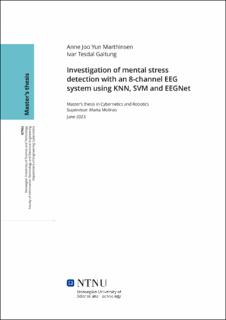| dc.contributor.advisor | Molinas, Marta | |
| dc.contributor.author | Galtung, Ivar Tesdal | |
| dc.contributor.author | Marthinsen, Anne Joo Yun | |
| dc.date.accessioned | 2023-09-29T17:22:10Z | |
| dc.date.available | 2023-09-29T17:22:10Z | |
| dc.date.issued | 2023 | |
| dc.identifier | no.ntnu:inspera:140443607:37066434 | |
| dc.identifier.uri | https://hdl.handle.net/11250/3093207 | |
| dc.description.abstract | Det er viktig å påpeke at dette arbeidet er gjort som en fortsettelse av prosjektoppgaven av Marthinsen [1]. Derfor vil det være seksjoner, spesielt i chapter 2, som vil være sterkt inspirert av eller direkte gjenbrukt fra prosjektoppgaven. Målet med prosjektoppgaven var å undersøke potensialet for å bruke
Electroencephalography (EEG) til å oppdage mentalt stress. Studien fant at den mest vellykkede modellen involverte bruk av Hjorth- funksjonsekstraksjon fra et ICAfiltrert, 32-kanals datasett som deretter ble klassifisert via K-Nearest-Neighbours (KNN) klassifisering. Denne metoden ga nøyaktighets-, følsomhets- og
spesifisitetsrater på henholdsvis 96,50%, 97,18% og 95,89%. Disse funnene antyder at visse klassifiserings- og funksjonsekstraksjonsmetoder kan være effektive for å identifisere mentalt stress fra EEG-data. Imidlertid var utvalgsstørrelsen i denne studien relativt liten, og ytterligere forskning med en større utvalgsstørrelse vil være nødvendig for å verifisere disse funnene.
I denne studien ble det samlet inn et mer begrenset EEG-datasett med en 8- kanals EEG-konfigurasjon. Det nye datasettet gjennomgikk pre-prosessering og filtreringsprosedyrer som var identiske med de som ble brukt i prosjektoppgaven. Etter dette ble datasettet klassifisert ved hjelp av de samme metodene som før.
Resultatene var imidlertid ikke like tilfredsstillende som tildligere, noe som gjorde det nødvendig å utforske alternative metoder. Derfor ble EEGNets’ Convolutional Neural Networks (CNNs), som er spesialisert på klassifisering av EEG-data, tatt i bruk, i tillegg til en implementasjon av Deep og Shallow CNNs. Videre ble nye
tilnærminger for filtrering og funksjonsekstraksjon testet.
De beste resultatene ved bruk av tradisjonelle klassifiseringsmetoder ble oppnådd ved bruk av fullstendige RÅ-data med SVM (nøyaktighet: 87,507%, følsomhet: 81,25%, spesifisitet: 92,05%), tidsseriefunksjoner av RÅ-data med SVM (nøyaktighet: 86,84%, følsomhet: 82,81%, spesifisitet: 98,77%) og bølge-spredningstransformasjon funksjoner av RÅ-data med SVM (nøyaktighet: 87,50%, følsomhet: 82,81%, spesifisitet: 90,91%). Dype CNN-modeller presterte også tilfredsstillende, hvor den best-presterende modellen var Shallow CNN med en gjennomsnittlig nøyaktighet på 83,66% på tvers av alle folder. Det antas at bruken av ICA for filtrering ikke var like effektiv som i den tidligere studien. Med det sagt viste rådataene lovende resultater for å fange mentalt stress ved bruk av CNNs til klassifisering. Dermed ser det ut til at reduksjonen i antall målepunkter fra 32 til 8 har begrenset studien, noe som understreker behovet for en mer omfattende tilnærming i fremtidig forskning. | |
| dc.description.abstract | It is important to preface that this work is done in continuation of the project thesis by Marthinsen [1]. Thus there will be sections, especially in chapter 2, that will be heavily inspired by or directly repurposed from the project thesis.
The aim of the project thesis was to investigate the potential use of Electroencephalography (EEG) for detecting mental stress. The study found that the most successful approach involved utilizing Hjorth features extracted from an ICA-filtered, 32-channeled dataset, which was subsequently classified via the K-Nearest-Neighbours (KNN) classifier. This method yielded accuracy, sensitivity, and specificity rates of 96.50%, 7.18%, and 95.89%, respectively. These findings suggest that certain classifiers and feature extraction methods can be effective for identifying mental stress from EEG data. However, the sample size in the project thesis was relatively small, and further research involving a larger sample size would be necessary to verify these findings.
In this study, a more restricted EEG dataset was gathered with an 8-channel EEG configuration. The new dataset underwent pre-processing and filtering procedures identical to those applied in the project thesis. Following this, the dataset was classified utilizing the same methods as before. However, the results were
not as satisfactory as in the previous study, necessitating the exploration of alternative options. Subsequently, EEGNets’ Convolutional Neural Networks (CNNs), which are specialized in the classification of EEG data, were employed, as well as an implementation of Deep and Shallow CNNs. Furthermore, new approaches for
filtering and feature extraction were tested.
The best results using traditional classifiers were obtained using full RAW data with SVM (accuracy: 87.50%, sensitivity: 81.25%, specificity: 92.05%), time series features of RAW data with SVM (accuracy: 86.84%, sensitivity: 82.81%, specificity: 98.77%) and wavelet scattering features of RAW data with SVM (accuracy: 87.50%, sensitivity: 82.81%, specificity: 90.91%). Deep Convolutional Neural Network models also performed satisfactorily with the best-performing model being the Shallow CNN with a mean accuracy of 83.66% across all folds. It is believed that the use of ICA for filtering did not prove as effective as in the earlier study. With that said the raw data showed promising results for capturing mental stress when using CNNs. As such, the reduction in the number of measuring points from 32 to 8 appears to have constrained the study, underscoring the need for a more comprehensive approach in future research. | |
| dc.language | eng | |
| dc.publisher | NTNU | |
| dc.title | Investigation of mental stress detection with an 8-channel EEG system using KNN, SVM and EEGNet | |
| dc.type | Master thesis | |
